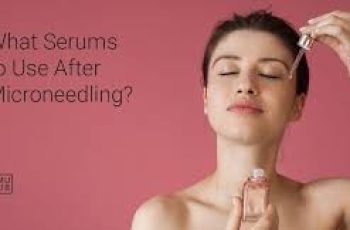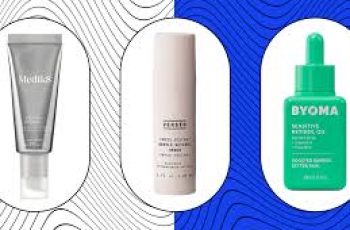
What Products Can Be Used With Retinol? A Comprehensive Guide
Whether you’re just starting to build your skincare routine or you’ve been obsessed with skincare for years, there’s one ingredient that consistently gets attention: retinol.
It’s known for its effectiveness in transforming skin, but with great power comes great responsibility.
If you’ve ever wondered what products can be safely paired with retinol, you’re in the right place. This blog aims to provide all the information you need to become a retinol expert.
After reading, you’ll feel more confident in combining products to maximize results while keeping your skin healthy and glowing.
What Is Retinol?
Retinol, a derivative of vitamin A, is one of the most beloved and highly regarded ingredients in skincare.
It’s particularly famous for its ability to smooth fine lines, reduce wrinkles, and even out skin tone.
Retinol stimulates collagen production, helps with skin turnover, and is generally a go-to solution for both anti-aging and acne.
However, because it’s a powerful ingredient, it requires some careful thought when combining it with other products.
What Products Can Be Used with Retinol?
The good news is that retinol can be used with many other products. But, it’s crucial to know which products should be avoided and which ones work well in synergy.
Overusing certain ingredients or combining them incorrectly can result in skin irritation, dryness, and redness.
The goal is to create a skincare routine that allows retinol to work effectively while keeping your skin barrier intact.
1. Moisturizers and Hydrating Serums
When using retinol, hydration is key. Retinol can be drying, which is why pairing it with moisturizers and serums that contain hydrating ingredients is essential.
One of the most effective ingredients you can use alongside retinol is hyaluronic acid. Hyaluronic acid works as a humectant, drawing moisture into the skin and keeping it plump and hydrated.
In addition to hyaluronic acid, niacinamide is another fantastic pairing. Niacinamide, also known as vitamin B3, helps to improve the skin’s natural barrier, reduce redness, and even out skin tone.
It can balance out some of the drying effects of retinol, making it a great product to use in your routine.
Consider incorporating both in your skincare to maintain moisture and ensure that your skin feels comfortable despite using such potent ingredients.
2. Vitamin C and Retinol: A Delicate Relationship
Although vitamin C is a skincare powerhouse, it’s important to be careful when using it alongside retinol.
Vitamin C is an antioxidant that protects the skin from free radicals, environmental stressors, and UV damage.
On the other hand, retinol is primarily used at night to stimulate collagen production and regenerate the skin.
While vitamin C is beneficial in the morning, it’s best not to use it in conjunction with retinol at night.
Vitamin C has a low pH, and when paired with retinol, it can increase the risk of irritation, especially if both are potent formulations.
However, you can still use both ingredients—just not at the same time. Apply vitamin C in the morning, followed by sunscreen, and use retinol at night.
This way, you maximize the benefits of both ingredients without overwhelming your skin.
3. Sunscreen: The Essential Companion to Retinol
The most important product you should never skip when using retinol is sunscreen. Retinol increases the skin’s sensitivity to UV rays, making it more prone to sunburn and photoaging.
If you don’t apply sunscreen daily, all your efforts in treating your skin with retinol could be undone by the harmful effects of the sun.
Make sure to use a broad-spectrum sunscreen with an SPF of at least 30, preferably higher if you spend a lot of time outdoors.
Protecting your skin from UV radiation will help maintain the results you get from retinol while preventing further skin damage.
4. Exfoliating Acids and Retinol: Proceed with Caution
AHAs (alpha hydroxy acids) and BHAs (beta hydroxy acids) are commonly used in skincare for exfoliation.
These acids, such as glycolic acid and salicylic acid, can help to remove dead skin cells and clear pores.
While they are great for exfoliating and improving skin texture, they shouldn’t be used in conjunction with retinol.
Both exfoliants and retinol are active ingredients, and when combined, they can cause excessive irritation and dryness.
Over-exfoliating with AHAs/BHAs while using retinol could lead to compromised skin, inflammation, and peeling. Therefore, it’s best to avoid using chemical exfoliants when you’re on a retinol regimen. If you wish to include them in your routine, alternate days between using retinol and exfoliating acids.
5. Salicylic Acid and Retinol: Timing is Key
You might be wondering about using a salicylic acid cleanser with retinol. The short answer is: it’s possible, but timing is crucial.
Salicylic acid is a powerful exfoliant, and retinol encourages skin turnover. The combination of both, especially if used at the same time, can lead to irritation and dryness.
If you want to incorporate both into your routine, it’s better to use salicylic acid in the morning and retinol at night.
This allows each product to work effectively without overlapping and causing irritation. Be sure to also follow up with a hydrating moisturizer after using salicylic acid to replenish moisture.
6. Retinol and Moisturizer: A Perfect Match
You can absolutely use a moisturizer with retinol, and it’s often recommended to do so.
Retinol can be drying, so applying a moisturizer afterward will help seal in hydration and protect the skin barrier.
The moisturizer acts as a protective layer, locking in the active ingredients and preventing them from evaporating.
Look for a moisturizer that’s rich in soothing ingredients like ceramides, glycerin, or aloe vera.
This will not only enhance the hydrating effect but also reduce any potential irritation caused by retinol.
A thick, emollient-rich cream is particularly effective in creating a barrier to protect the skin overnight.
7. Retinol with Other Anti-Aging Ingredients
Retinol is commonly used in anti-aging skincare routines, but it can also work well with other anti-aging ingredients.
For instance, peptides can be used in conjunction with retinol to support collagen production and improve skin elasticity.
Growth factors, which help to stimulate cell turnover and repair the skin, are also effective when used alongside retinol.
When using multiple anti-aging products together, always monitor your skin’s response. Introduce new products slowly and in small amounts to avoid overwhelming your skin.
The goal is to create a routine that delivers visible results without causing irritation or sensitivity.
8. Can Retinol Be Used with Other Acne Treatments?
If you’re using retinol for acne treatment, you might be curious about whether it can be combined with other acne medications like benzoyl peroxide or salicylic acid.
The answer is: it’s possible, but it requires caution.
Both benzoyl peroxide and retinol are effective in treating acne, but using them together can lead to excessive dryness and irritation.
If you want to use both, it’s better to apply benzoyl peroxide in the morning and retinol at night.
This helps prevent irritation and ensures that both ingredients can work effectively without interfering with one another.
How to Build a Skincare Routine with Retinol
Morning Routine:
Start with a gentle cleanser.
Apply vitamin C serum (optional but recommended for its antioxidant properties).
Follow with a moisturizer and sunscreen with SPF 30 or higher.
Evening Routine:
Cleanse with a mild cleanser.
Apply retinol (start with a lower concentration if you’re new to retinol).
Follow with a soothing moisturizer to lock in hydration.
Final Thoughts
Incorporating retinol into your skincare routine can deliver impressive results, from reducing fine lines to improving skin texture.
But knowing which products to pair with it is essential to maximize its benefits while keeping your skin balanced and healthy.
Always make sure to layer your skincare products in a way that avoids irritation and prioritizes hydration.
And remember, consistency is key when using retinol. Stick with it, and you’ll see positive changes in your skin over time.
I hope this guide has answered your questions about what products can be used with retinol.
If you have more skincare queries, be sure to follow us on Instagram for daily tips, product launches, and exclusive discounts. You can also PM me anytime—I’m always happy to help!


